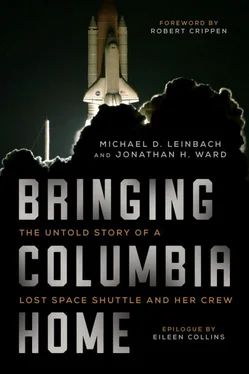“As a shuttle pilot, I knew exactly what those switches meant,” Melroy said, “and I was absolutely electrified!” The crew—“demonstrating excellent systems knowledge by taking actions not simulated in training”—had attempted to get the hydraulic systems working again after the ship lost control. Melroy said, “They were our heroes. Somehow, it made it easier to bear, knowing they were not helpless, but instead were fighting to save the vehicle in their last moments—right up to the end.” [13] Pam Melroy email to Jonathan Ward; NASA, Crew Survival Investigation Report 3-69–3-70.
The four hundred–page crew survival investigation report, released in 2008, confirmed that the accident was not survivable. Rather than the CAIB’s general finding that plasma intrusion caused the left wing to fail, the survivability study presented a detailed analysis and timeline of how Columbia actually broke up. The proximal cause of the accident was the loss of hydraulic pressure after the system was breached by plasma in the left wing. This caused the ship’s control surfaces to stop responding to steering commands. Columbia went into a flat spin. The crew knew their ship was in trouble. They tried to save it after it went out of control, during a period that lasted at most thirty seconds. The ship broke up due to aerodynamic forces, starting with the left wing. A breach in the crew module caused it to depressurize rapidly, shortly after the body of the ship came apart. The crew lost consciousness almost instantaneously. They did not even have time to lower their helmet visors.
The survivability group’s report included multiple, detailed recommendations on the design of crew-worn equipment, seats and restraints, and the crew compartments for future space vehicles. The report also contained suggestions for crew training and procedures to cope with emergency situations.
NASA’s response to the report was positive and supportive. “In the end,” Melroy said, “it made me feel better to know that people were saying, ‘There are no holds barred—if there’s a way of making things better, we’ll do it.’ It reminded me of what a great culture NASA has—that we are committed to learn everything we can from tragedies.”
—
United Space Alliance’s Amy Mangiacapra was Columbia ’s first caretaker and curator, a role she held for ten years. “I maintained the temperature and humidity in the room, made sure everything stayed clean and dust free, gave tours to senators, even scrubbed the floors,” she said. “The room is really remote. There’s nobody around. I was totally by myself, for eight to twelve hours a day, surrounded by Columbia . She was like one of my children. You can’t pour that many years into something that special and come away without being completely changed. It was an honor to say that every day I got to go to work and take care of Columbia .”
NASA transitioned the preservation office curator role from a contractor to a permanent NASA staff position. Mike Ciannilli assumed the lead role, and by January 2016, his charter expanded to include NASA’s new Apollo, Challenger, and Columbia lessons learned program.
KSC strongly urges all new employees—interns, contractors, and civil servants alike—to tour the Columbia room with Ciannilli soon after they begin working at KSC. His orientation emphasizes how culture and complacency led to the spacecraft accidents and how individual actions might have made a difference.
Selected artifacts from Columbia toured all of the NASA centers in 2008 to reinforce the agency’s safety culture. “It’s not to point fingers or lay blame,” Ciannilli said, “but people need to understand why it’s important for every single person to be vigilant every day. You can tell them that, and sometimes it doesn’t sink in. But after people see the debris, they say, ‘Wow—I really get it now.’”
Being in the Columbia room changes people, forcing them to think and reflect. After touring the facility, NASA Administrator and former astronaut—and Columbia pilot—Charlie Bolden was visibly shaken. He asked Ciannilli, “How can you do this every day?”
Ciannilli responded, “I try to focus on the good that Columbia does in changing people’s hearts and minds. I don’t do it— Columbia does it. She has the loudest voice. She speaks more eloquently than anyone ever could.”
The Columbia room’s 6,800–square foot area does not afford enough space to exhibit every piece of debris. Amy Mangiacapra, Steve Altemus, and Jim Comer selected representative items that are readily recognizable and that tell a story about the accident or the investigation. Educational posters and placards around the room provide details about the items and the recovery and reconstruction efforts. Signed banners—along with hundreds of cards, letters, and posters from schoolchildren—decorate the walls in the room.
An unmarked, locked room off to one side contains the reconstructed crew module. This room is open only to crew families, astronauts, and investigators.
The cockpit window frames, which used to be the first items visitors saw upon entering the room, were relocated in 2016 to the Forever Remembered exhibit at the Atlantis building at the KSC Visitor Complex. Now, one first sees the remains of Columbia ’s air lock and tunnel to the Spacehab module, assembled horizontally on three frames. A rack nearby holds the remnants of maneuvering thrusters.
Columbia ’s nose landing gear strut lies near the front of the room. A pan underneath the piston still catches occasional drops of hydraulic fluid leaking from the strut. The left main landing gear strut and its tires are also on display, showing how heat entering the left wing affected the inboard and outboard tires differently.
Racks on the right-hand wall hold avionics boxes from Columbia ’s instrument bay. Some are badly melted and almost unidentifiable. Others are relatively pristine, with serial numbers still clearly legible.
A section of Columbia ’s vertical stabilizer is surrounded by sections of the right and left pods flanking it on the ship. The pieces clearly tell the tale of how the accident originated on the left wing of the ship. The left maneuvering system pod and left side of the tail are pitted and slumped, with globules of metal melted into the tile. The right side pod has none of that kind of damage.
Lexan frames holding about half of the leading edge of Columbia ’s left wing exhibit the damage in the vicinity of panels 8 and 9, where the wing breach occurred. Across the aisle is a section of the left wing tile table, containing the recovered tiles from the left wing behind the breach. The tiny “Littlefield Tile”—the farthest west piece of debris recovered—rests on a shelf nearby.
Columbia ’s nose cap sits on a pallet, still bearing sticks, grass, and dirt from the forest floor from where it was recovered in Sabine County. The engine powerheads that were pulled from mud-filled craters in Louisiana lie on pallets with other pieces of wreckage from Columbia ’s aft structures.
Starting about one hundred feet back into the room, scores of triple wall storage boxes—bearing labels such as BODY FLAP BOX 1 or PLUMBING-UNIDENTIFIED—line the walls and contain the bulk of Columbia ’s debris.
Two rooms at the far end of the facility hold the dozens of cryogenic and propellant tanks that were recovered from the field. Some look as though they merely floated to Earth. Others are dented or covered with shredded Kevlar. The lighter objects slowed down rapidly in the upper atmosphere and fell out of the sky. The heavier ones traveled farther and impacted the ground at higher speeds, some still supersonic.
Читать дальше











